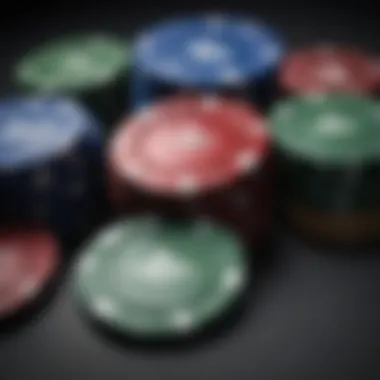Understanding the Importance of Poker Chip Values


Intro
Poker chips stand at the crossroads of strategy and chance, embodying a complex set of values in both literal and figurative senses. Rather than simply serving as currency in the high-stakes game of poker, these tokens play an essential role in shaping player psychology, influencing decisions, and even reflecting the history and design nuances unique to various gaming environments. For those who simply see chips as mere objects, it may be time to take a closer look at what they represent.
Each chip isn't just a piece of clay or plastic; it's a symbol of potential victory or loss, hopes and dreams—all packaged into a simple, colorful disc. The psychological implications are woven into how players interact with these chips, often correlating their values with their self-worth and gambling prowess.
In this article, we aim to unpack the significance these poker chips hold, going well beyond their surface value. We'll explore their representation in crucial game mechanics, design evolution through the years, and their weighty impact on gameplay tactics. With a well-rounded analysis that touches on casual play to professional stages, we dive into this vibrant landscape where chips and players mingle with heated intensity.
Why Focus on Chips?
- Historical Context: Understanding where poker chips originated helps us appreciate their evolution in game settings.
- Design Elements: A look into how colors, sizes, and inscriptions contribute to player experience.
- Psychological Effects: How the value of chips can trigger diverse emotions ranging from confidence to anxiety.
With the stage set, let us now journey deeper into this compelling topic.
Foreword to Poker Chips
In the vast realm of gambling, poker chips stand out as more than mere tokens; they represent the fabric of gameplay itself. Understanding the significance of poker chips is paramount for anyone looking to navigate the nuanced landscape of poker, whether you're a seasoned player or a curious novice. This section aims to lay the groundwork for why poker chips matter, detailing their role, functionality, and the social aspects tied to them.
Definitions and Basic Concepts
To grasp the importance of poker chips, we first need to delve into their definitions and fundamental concepts. Poker chips are essentially circular discs made from various materials like clay, ceramic, or plastic, used in place of cash during gameplay. Each chip carries an assigned value, representing real money in a casino setting or for casual games among friends. Their purpose extends beyond serving as a currency; they embody the stakes of the game, the tension at the table, and even the social dynamics among players.
In essence, a poker chip is a tactile reminder of the gamble at hand. Its value isn’t merely numeric; it's infused with psychological weight that can influence the betting behavior and strategy of players. When one picks up a chip, the weight of risk, reward, and competition becomes palpable. That feeling is integral to the thrill of poker, allowing for emotional engagement as well as strategic calculations.
The Structure of Poker Chips
The structure of poker chips varies according to their type and value. Understanding these differences is crucial for players who want to maximize their gameplay experience. Most poker chips consist of a core, typically made from a composite material, enclosed in a layer of clay or plastic. The weight, texture, and even the sound a chip makes when it hits the poker table can evoke a certain ambiance, enriching the overall gaming experience.
Different materials can correspond to different values. For instance, a heavier ceramic chip may proclaim a larger stake, while lightweight plastic ones might denote smaller bets. Moreover, the design — colors and markings — aids players in quickly identifying the value of each chip.
This structure is particularly important in a casino context, where the rapid exchange of chips can quicken the pace of gameplay and raise the stakes almost instantaneously. Understanding the significance of chip structure can help players make educated decisions, effectively navigating the odds and improving their strategy.
"In poker, chips are not just for betting; they are the pulse of the game, reflecting risk, strategy, and the player’s psyche."
Historical Context of Poker Chips
Understanding the historical context of poker chips is essential to appreciate their role in the gaming experience today. Since their introduction, poker chips have evolved far beyond simple currency substitutes. They represent not just monetary value but also a cultural artifact of the gambling world, integrating various traditions, designs, and practices.
Early History and Evolution
The origins of poker chips date back to the early days of gambling. Early gambling games saw players using whatever was at hand for wagers—coins, stones, or even pieces of clay. It was in the 19th century that poker chips, in a more standardized form, began to take shape.
- Origins in Europe: Initially, gambling games in Europe did not feature special chips. The coins used often varied in value, and it could easily lead to disputes among players.
- Introduction of Clay Chips: The first known poker chips were made of clay and emerged in the mid-1800s in the United States. These chips were crafted for better usability, allowing for predetermined values attached to specific colors.
- Advent of Personalized Chips: Casinos began to adopt custom designs, often including the casino's logo or branding on the chips. This aspect was significant in building a casino's identity and reputation.
The evolution of poker chips reflects greater trends in society's relationship with gambling. As gaming moved from homes and private settings to public casinos, the need for uniformity and standardized values became apparent. Chips became more than just objects; they embodied the culture and excitement surrounding card games.
Modern Developments in Design
As the gaming industry grew, so did the creativity and complexity behind poker chip design. Modern poker chips are crafted with meticulous attention to detail, incorporating both aesthetic and functional elements.
- Materials and Technology: Today's chips are made from a blend of clay composite and ceramic materials, making them durable and providing a pleasing tactile experience. The switch from pure clay to hybrid materials also allows for intricate designs and durability during rigorous gaming.
- Security Features: In response to the need for security, casinos have integrated technology into chip design. Some chips now feature RFID (Radio-Frequency Identification) tags, which help track chips and prevent counterfeiting.
- Variety in Styles: From holographic elements to metallic finishes, the designs of poker chips can vary significantly. This variety not only captures a player's eye but also adds layers of meaning. For example, certain designs may symbolize a particular casino's brand or heritage, contributing to a player's connection with the venue.
"In the world of poker, chips signify more than just value; they embody a narrative woven through history and culture, symbolizing the passion and excitement of the game."
Understanding Values on Poker Chips


In the realm of poker, the values assigned to chips are more than mere numbers; they serve as the backbone of gameplay, influencing strategies and interactions among players. Understanding these values can significantly impact not only one’s performance at the table but also the overall gaming experience. A deep dive into the assigned values and how they standardize across casinos reveals both functional and psychological dimensions of poker that every enthusiast should appreciate.
Assigned Values and Their Significance
The assigned values of poker chips are fundamental to the game. Each chip color corresponds to a specific monetary amount, allowing players to gauge their bets and manage their stacks efficiently without needing to count cash constantly. For instance, a red chip may typically represent $5, while a black one could indicate $100. This system neatly encapsulates the concept of value in poker, allowing for straightforward wagers, raises, and pot calculations.
Misunderstanding these values can lead to disastrous outcomes for players. Imagine depleting your stack due to miscalculating a bet simply because you underestimated a chip’s worth! This highlights why clear communication about designated values in a poker room is crucial.
Importantly, the psychological aspect cannot be overlooked. The perceived value of chips often influences players' decisions. A player may feel bold when they lay down a handful of high-value chips compared to several smaller ones. The same chips, simply by their assigned value, can change the dynamics around the table, enhancing confidence or breeding apprehension.
Moreover, these values are not static; they can vary depending on game type and stakes. Adapting to these changing values in a live environment or online platform is part of a good strategy. Establishing a familiarity with the chip values at the outset defines a player’s ability to engage effectively in both casual and competitive settings.
Standardization Across Casinos
Standardization plays a vital role in ensuring a seamless poker experience across different venues. While individual casinos might have their unique styles and slight variations in colors or materials, the values assigned to chips are largely consistent within a specific locality. This uniformity helps players transition from one casino to another without confusion, allowing them to focus on the game rather than deciphering different chip values.
Regulations typically govern these standards, with gaming commissions overseeing the allotment of chip values. This means that, for the avid traveler, a poker chip in Las Vegas typically will hold the same value in New Jersey. Players can enjoy the game regardless of location, eliminating anxiety about unfamiliar chip systems.
On the other hand, there’s a fascinating aspect of local flavors and customs that influence chip design and value assignment. In some regions, chips might carry unique markings or symbols that resonate with local cultures, making them valuable not just for gameplay but also as collectible items. Thus, the careful balance between maintaining standard values and embracing local uniqueness contributes to a richer poker environment, attracting enthusiasts from all walks of life.
Types of Poker Chips
When we dive into the world of poker, the type of chips can play a significant role in how games unfold. Understanding the nature of these chips not only enhances the game experience but also influences strategy and player interaction. This section will explore the three primary types of poker chips: clay composite chips, ceramic chips, and plastic chips. Each type comes with its distinct features, and knowing which one to use or prefer can make a big difference in the game.
Clay Composite Chips
Clay composite chips are often favored by serious poker players and are commonly found in casinos around the globe. These chips are not made purely of clay; rather, they are crafted from a mixture of clay and other materials, usually resin or limestone, giving them durability along with that classic feel.
The importance of clay composite chips lies in their weight, texture, and sound when stacked or shuffled. Players tend to appreciate the tactile experience that these chips provide. They generally weigh between 11.5 grams and 14 grams, which feels substantial and satisfying in hand. Moreover, the distinctive "clink" sound they make when tossed on the table can add to the atmosphere of the game.
However, it’s worth pondering their lifespan. While they resist wear and tear better than pure clay options, they can still chip or fade if mistreated. It's advisable to handle them with care during gameplay. Thus, paying attention to their maintenance is crucial for longevity.
Ceramic Chips
Ceramic chips represent a newer wave in the poker chip world. Unlike their clay composite counterparts, these chips are made from a solid ceramic material, which allows for a higher level of customization in terms of design. In fact, many home games use ceramic chips for their vivid graphics and intricate logos, which can lend a more professional look to casual play.
One of the key benefits of ceramic chips is their durability. They don’t wear down easily, and they maintain their appearance over the years. These chips tend to be smoother than clay composites, giving them a sleek feel in hand. This characteristic also allows for various finishes, from matte to glossy, offering visual appeal during the game. Players enjoy the aesthetic satisfaction these chips deliver.
Specific designs can help direct the psyche of the game. For instance, unique symbols or images could impact how players perceive value or even intimidate opponents. In this way, the design of ceramic chips can play psychological games during high-stakes poker sessions.
Plastic Chips
Plastic chips are the most economical option available. They are lightweight and often used in home games rather than commercial establishments. Though easy on the wallet, they lack some of the tactile quality and aesthetic appeal of clay composite and ceramic chips. Many players might regard plastic chips as "cheap," but they serve their purpose well in casual environments.
These chips typically weigh less, usually around 10 grams, and this lighter weight might influence gameplay strategies. For instance, they can slide easily on the table, leading to faster rounds. Plus, they are more likely to withstand rough handling because they don't chip as quickly as other materials do.
If you're throwing a poker night with friends, plastic chips can get the job done neatly without burning a hole in your pocket. However, it’s essential to acknowledge that they may not provide the same rich experience that seasoned players seek, particularly in high-stakes scenarios.
Ending
Whether it’s the prestige of clay composite chips, the customized elegance of ceramic, or the practicality of plastic chips, understanding these options allows players to choose the best fit for their gaming style. Each type brings its own flair, characteristics, and considerations, enhancing the overall poker experience.
Design Elements of Poker Chips
When sitting down at a poker table, you might not immediately notice the role design elements play in the world of poker chips. However, these aspects are significant, influencing both the game itself and player perceptions. Chips are not just a medium for placing bets; they embody the aesthetic and functional components that contribute to the entire playing experience. Let's dive into some of these essential features.
Color Coding and its Purpose


Color coding is perhaps the most recognizable and functional design feature of poker chips. Each hue represents a specific value, allowing players to quickly ascertain how much they are risking or winning without needing to check each chip closely. For example, in many settings, a white chip often stands for one unit, while red might equal five, and green could signify twenty-five. This visual differentiation enhances gameplay efficiency.
Furthermore, color coding goes beyond mere convenience. It communicates the intrinsic hierarchy within the game — creating a subtle yet powerful psychological influence. When a player waves around a stack of green and black chips, it's a clear unspoken message of confidence or superiority. This is not just gamified art, it calls into play the social dynamics within the poker community, impacting strategy and interactions among players.
"The visual cues from chip colors create a battlefield of minds, where perception often trumps reality."
Incorporating Symbols and Logos
Another significant element of poker chip design is the inclusion of symbols and logos. These elements can serve multiple purposes, from branding to creating an identity for the game. Many casinos utilize unique insignias or designs, which can be critical in distinguishing their chips from those of other establishments. This not only helps in preventing cheating but also helps build brand loyalty and recognition.
Symbols can also denote game type or special events, such as tournaments. For instance, a star symbol might indicate a championship chip, which carries weight and prestige. Players are often drawn to these chips, not only for what they represent in terms of monetary value but also for the status they convey.
Incorporating logos or emblems also plays into the larger narrative of the casino experience. When a player uses chips adorned with particular designs, it ties them more intimately to the venue, enhancing their overall enjoyment. Whether it's a logo of an iconic brand or intricate designs that reflect local culture, these elements deepen the engagement with the physical gaming environment.
In summation, the design elements of poker chips—color coding and symbols—serve more than just functional purposes. They are key components that shape how players interact, perceive values, and engage with the game itself. Understanding these elements is crucial for anyone looking to delve deeper into the subtleties of the poker experience.
Poker Chips in Game Strategy
In the game of poker, chips are not just tokens exchanged for value; they carry weight in both strategy and psychological influence. The way players use their chips can turn the tide of a game. Understanding poker chips in the context of game strategy is essential for any player, whether they are a novice at the table or a seasoned pro looking to sharpen their skills.
The Psychology Behind Chip Value
Chips do more than represent monetary value; they embody power and control at the poker table. The mere presence of chips can shift the dynamics of gameplay. Players’ perceptions of wealth can affect their decisions. For instance, a player holding a hefty stack of high-value chips might feel more emboldened to make bold moves, going all-in on a whim, whereas a player with fewer chips might play conservatively—a classic case of put your money where your mouth is.
"The greater the stack, the heavier the play."
When analyzing the psychology behind chip values, it’s important to note that color and shape also play a critical role. Different colors signify varying values, which can subconsciously enhance or diminish a player’s confidence. For many, a big red chip may invoke feelings of bravery, whereas a small blue chip might signal caution. This kind of thinking can lead to strategic manipulation, where players bluff or feign a stronger hand based on their perceived stack size.
Chip Management Techniques
Effective chip management is a core skill that should not be overlooked. Skillful players learn to use their chips not just as a currency but as a tool of strategy. Here are some fundamental techniques:
- Stacking Wisely: Organizing chips by value allows for quick access and can help maintain a player’s focus. It keeps the brain clear of muddled thoughts regarding less critical chips.
- Betting Patterns: Adapting to different betting styles can provide insights into opponents’ strategies. Whether it’s a smooth bet or a hefty raise, varying chip movements can mask one’s true intentions.
- Reading the Room: Observing how others manage their chips might provide clues to their overall strategy. If a player suddenly jettisons a large number of chips on a stack, it may be time to reassess your game plan.
- Small Bets, Big Moves: Sometimes it's the subtle bets that reap the greatest rewards. A well-placed small bet can provoke reactions that provide insight into an opponent's strength.
- Preserving Chips: Knowing when to fold or make a calculated risk can preserve one’s chip pile for longer stretches, allowing for strategic positioning later in the game.
Success in poker goes beyond luck; it's about understanding the myriad ways chip dynamics influence gameplay. By grasping the psychological implications and employing sound chip management techniques, players can fortify their strategic approach, leading to greater success at the tables.
The Casino Experience
The casino is more than just a building filled with slot machines and poker tables; it's an entire ecosystem designed to captivate and engage. Within this vibrant environment, poker chips play a crucial part. Their significance stretches far beyond mere accessories for games; they are integral to the overall casino experience. This section aims to explore the various dimensions of how poker chips enhance gameplay and the etiquette surrounding their handling, providing insights into why chips are central to a successful casino atmosphere.
How Chips Enhance Gameplay
When players enter a casino with chips in hand, they don't just see fractions of currency; what they see are gateways to opportunities and emotions. Each chip—be it a high-roller’s phantasmagoria or a casual player’s arsenal—serves a purpose that stretches into the psychology of gaming.
- Visual Recognition: The colors and weights of chips are not arbitrary; they are crafted to reflect their assigned values, making transactions quick and intuitive. Players can glance at the layout and instantly identify their stake and standing in the game.
- Creating Stakes: Poker chips make it easy to track bets over the course of the game. As the game develops, players can physically manage their chips, which enhances their emotional stakes in the proceedings. The tactile sensation of handling chips often draws players deeper into the experience.
- Facilitating Strategy: Experienced players use chips not just as currency but as tools in their strategic play. For example, they may employ a technique where they stack or arrange chips in visual formations that serve as reminders of their betting strategy. It’s all about communication with oneself while engaged in the game.
- Building Excitement: A simple act like churning stacks of chips or confidently putting down a hefty wager can be a way to convey confidence and assert dominance. The sound of chips clinking together can amplify tension at the table, really adding to the thrill of the game.
Through these dynamics, poker chips do more than just serve as currency; they assist players in navigating their experiences more deliberately.
Chip Handling and Etiquette
Poker chips come with their own unwritten rules and norms. Understanding these can elevate a player’s reputation and enhance the enjoyment of everyone involved.
- Respect for the Game: Always treat chips as valuables—not mere tokens. This means handling them with care, avoiding tossing them or engaging in disruptive behavior that could distract others.
- Stacking and Betting: Players should learn to stack their chips neatly and present them when placing a bet. A sloppy bet may not only confuse fellow players but can also signal disorganization, which is frowned upon.
- Chips in Motion: Passing chips to a dealer or another player should always be done with a degree of reverence. A smooth, deliberate motion conveys respect and encourages a positive atmosphere.
- Informing Others: If a player is out of chips, it’s considered polite to inform others rather than letting your stack dwindle to a point of uncertainty. Being clear improves the overall experience.
"In poker, the proper handling of chips can define the unsaid respect at a table, enforcing the spirit of the game beyond odds and chance."


This etiquette ensures that gaming tables become enjoyable spaces where everyone can focus on the game itself, rather than on how chips are being mishandled or disrespected.
As poker evolves, the experience within the casino also shifts, but the value of poker chips will remain a constant. From enhancing gameplay to adhering to unwritten norms, they are essential threads in the fabric of casino life.
Technological Innovations
The landscape of poker chips has seen significant shifts due to advancements in technology. Casino managers and poker players alike have begun recognizing how these innovations not only improve gameplay but also enhance security and efficiency. The evolving nature of poker chips extends far beyond aesthetics, touching on functionality and the overall gaming experience. In this section, we examine the rise of smart chips and the future of poker chips in the digital realm, highlighting their implications on gameplay and industry practices.
Smart Chips and Their Functionality
Smart chips have recently emerged as a groundbreaking development in the world of poker. These chips come embedded with RFID technology, allowing casinos to track bets and player movements in real time. This technology offers numerous benefits:
- Enhanced Security: With the ability to monitor chips, casinos reduce the risk of counterfeiting and fraud. The live tracking alerts management to potential inconsistencies or theft.
- Efficient Operations: Automated tracking means less time spent on manual counting and more time focused on customer service. This streamlines operations significantly.
- Detailed Player Insights: Casinos can gather data on playing habits and preferences, enabling them to provide personalized experiences, which can be a game-changer in customer retention.
However, there are considerations too. Such technology can sometimes create a sense of detachment for traditional players who appreciate the tactile experience of handling physical chips. Balancing innovation with the gambling spirit is key, as some players may miss the genuine feel of playing with classic chips.
The Future of Poker Chips in Digital Gaming
As the gambling industry continues to evolve, digital gaming is becoming a dominant force. The future of poker chips is likely to align with the increasing prevalence of online platforms and mobile apps. This shift raises several intriguing possibilities.
- Virtual Reality Integration: Imagine stepping into a virtual casino where poker chips are represented as digital assets with unique values. This kind of integration could revolutionize how players interact with the game, providing an immersive experience without the need for physical chips.
- Cryptocurrency Adoption: Some casinos are beginning to accept cryptocurrencies, and poker chips could take on a digital form, presenting values stored as blockchain tokens. This could enable instant transactions, pushing forward efficiency in gaming transactions.
- Adaptability and Customization: As players demand more unique experiences, future designs of poker chips could allow for customizable values and features, all linked to a player's digital identity.
"With each passing day, technology reshapes the way we engage with games that have been around for ages, potentially making them more accessible and enjoyable."
Global Perspectives on Poker Chips
Understanding poker chips transcends mere gameplay; it dives into the heart of culture and legality that shapes how the game is played around the world. This significance reveals itself through various layers like local customs, economic factors, and legal frameworks that govern the use and design of these chips. In different parts of the globe, poker isn't merely a game but often a social interaction steeped in tradition. The narrative surrounding poker chips enriches the player experience, reflecting not just their monetary value but also their cultural resonance. By examining these global perspectives, we uncover the many reasons why these small tokens are crucial in both local and international gambling scenes.
Cultural Differences in Chip Use
When you set foot in a casino, you might notice the chips don’t all look the same. Each region has its flavor when it comes to the design and feel of poker chips. In some cultures, such as in the United States, chips are often vibrant and carry specific values that players recognize easily. Chess-like strategies in some poker games may require players to maintain a careful eye on the chip colors, which represent various denominations.
On the other hand, in Asia, you might see an entirely different approach. Countries like China and Japan have their unique versions of chips, sometimes even incorporating local symbols or motifs that reflect their heritage and traditions. For example, in some Asian settings, chips might feature intricate dragon designs or cultural symbols. These designs not only appeal aesthetically but often serve to create a sense of pride and ownership among local players.
Cultural variations in chip use extend beyond just colors and symbols—they can impact gameplay as well. Group play dynamics can shift significantly based on how players perceive these chips. In certain cultures, chips can represent status, often leading to different gameplay strategies and interactions. Players might adopt more aggressive styles if the chips they use are frenetic and flashy as opposed to simpler, more traditional designs present in quieter settings.
Regulations and Standard Practices Worldwide
The world of poker chips isn't just about design—it’s significantly influenced by regulations. Different countries have varying rules governing the use, design, and distribution of poker chips. In many places, chips can signify more than just a means to wager; they can also reflect local laws regarding gambling, taxation, and the prevention of fraud.
For instance, in countries like the United Kingdom, regulations ensure that casino chips adhere to strict standards of fairness and transparency. The UK Gambling Commission imposes requirements that chips must meet, including readability and clear denomination markings. This regulation prevents counterfeiting and assures players that the chips are secure and have real value.
Conversely, in some parts of Latin America, less stringent regulations might permit casinos to create their own customized chips, fostering an environment of creativity yet presenting a risk of disputes regarding worth and authenticity. Since gambling laws vary drastically across borders, players from these regions might face challenges that those from more regulated environments do not.
"The design and regulation of poker chips serve not only as practical tools for play but also as symbols of cultural identity, influencing how the game is approached globally."
In summary, as we explore the global perspectives on poker chips, it becomes clear that these tokens are not only essential for the mechanics of the game. They encapsulate the intersection of culture, legality, and individual practices that shape the gambling landscape in varied regions. By appreciating these differences, players gain a richer context in which they engage with the game.
The End: The Multifaceted Role of Poker Chips
The role of poker chips extends far beyond their function as simple tokens in a game. As this article has navigated through various facets of poker chips, it has become clear that their significance is deeply intertwined with the gaming experience, shaping not only the mechanics of play but also the psychological and cultural contexts that surround gambling. Understanding this multifaceted role allows players and industry stakeholders alike to appreciate the nuances that poker chips bring to the table.
Rethinking the Role of Poker Chips
When one thinks of poker chips, images of brightly colored disks come to mind, each representing a different value and facilitating the flow of the game. However, it's worth reconsidering and unpacking the deeper significance of these objects. Poker chips serve as a visual cue that can influence player behavior. For instance, higher-value chips can create a perception of high-stakes play, which might affect how players approach their decisions at the table.
Moreover, there’s also an aspect of social dynamics involved. The mere act of handling chips—stacking them, counting them, or exchanging them—can create a sense of status or identity in the gaming environment. This brings about an important consideration: the design and material of chips are not merely aesthetic choices but also play a role in the tactile experience that players have. The heft of a ceramic chip versus the lightness of a plastic one can shift perceptions about the game in ways that might not be immediately obvious.
Final Thoughts on Their Impact in Gaming
In the grand scope of casino culture, poker chips are indeed more than passive tokens. They hold a confluence of value, both in a monetary sense and in terms of player engagement. Players forge connections with these chips, as they often symbolize victories, strategies employed, or even the thrill of the chance. Their use not only enriches the gameplay but also reinforces the establishment of community among players, fostering interaction and competition.
"Poker chips encapsulate not merely the mechanics but the essence of the gambling experience itself. They represent bold risks taken, strategies crafted, and the excitement that pulses in a casino atmosphere."















